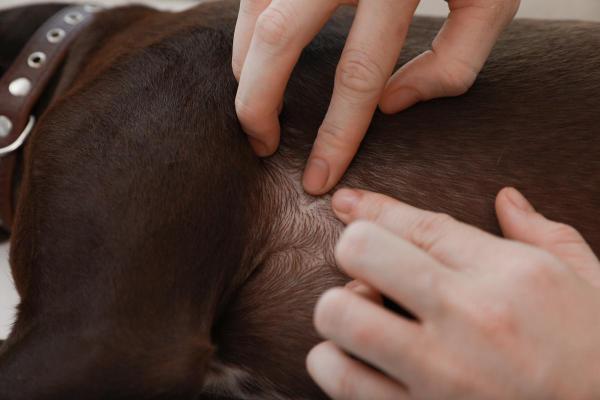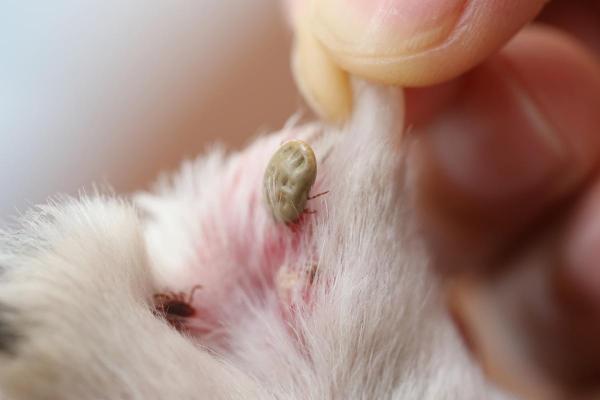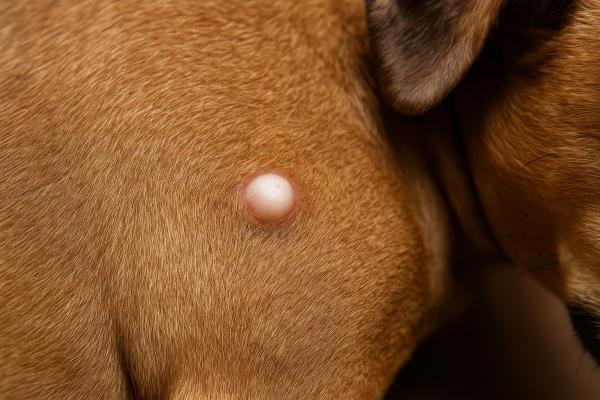My Dog Has White Spots on Their Skin



See files for Dogs
White spots on a dog's skin can appear almost anywhere. We might see one or more white spots on their nose, lip, ear, paw or even their tongue. Location is very important in helping a veterinarian determine the cause of the white spot, but there are other factors to consider. We also need to look at the shape and type of spot. For example, a small white pimple is unlikely to be the same as an extensive white patch. Concurrent symptoms can also help us to identify the cause of the white spot, such as if there is inflammation or redness around the site. We also need to be careful to see the depth of the spot as it is possible it is the top of a cyst or tumor.
AnimalWised looks at why my dog has white spots on their skin. We discover five common causes and treatments, but we must insist that only a veterinarian can diagnose the problem in your dog.
1. Whiteheads
While it may be more difficult to see than our own, a dog's skin functions in a very similar way. This makes it prone to similar problems, including the possibility of whiteheads. Whiteheads are a type of comedo. Comedones are blocked hair follicles which can be closed by skin or open. Closed comedones are whiteheads and open comedones are blackheads.
Blockages in the hair follicles or sebaceous glands cause sebum to accumulate. When the dead cells are not properly removed, they build up these natural oils and the comedo arises. Blockages can also be a result of dirt or environmental pollution. Regardless, the pore becomes blocked and a white spot can present. These have the risk of infection if bacteria enters, resulting in folliculitis.
The areas where comedones as white spots on dogs most commonly develop are the chin, back, abdomen and armpits. Breeds most frequently affected by these types of white spots include Boxers, Bulldogs and different types of Schnauzers. Comedones can also be chronic, in which case it will be considered acne.
Treatment of whiteheads in dogs
Treatment for comedones generally includes proper hygiene using antiseptics or baths with antiseptic shampoos containing chlorhexidine. Keeping the area clean is especially important. You should avoid touching your dog's whiteheads directly and do not pop them. This can cause them to become inflamed or infected.
In milder cases of white spots, topical treatment with antibacterial creams can be applied. Benzoyl peroxide or other prescription medications may be used for severe cases or chronic acne. Antibiotics will only be required if there is a serious infection.
Discover more about canine acne in our article asking does my dog have pimples?
2. Parasites
Some external parasites of our dogs can cause white spots to develop on their skin. These include mites, such as Demodex canis or Sarcoptes scabiei. These mites are present on a healthy dog's skin, but they can proliferate to the point they cause demodectic mange and sarcoptic mange, respectively. Fleas and ticks are other common external canine parasites.
These white pimples appear as a result of the body's inflammatory response after the parasite invades the skin or hair follicles. They may also bite the skin. The body reacts with inflammation and pus accumulation, leading to the formation of white bumps or pustules. Other common clinical signs include itching, redness, crusting, unpleasant odor, and oily or thickened skin. Some parasites can even lay eggs which appear as white spots.
Treatment of external parasites in dogs
Treatment is primarily based on deworming the dog to eliminate the infestation. This requires the use of a specific antiparasitic drug based on the type of parasite. Antibiotics will also be used if there is a secondary bacterial infection. We should also ensure we set up a deworming schedule to prevent parasites in the future.
In cases of intense itching or significant inflammation, the use of anti-inflammatory drugs or corticosteroids may also be indicated. Cleaning and deworming the dog's living environment is also necessary to prevent re reparasitization. To support treatment, medicated shampoos containing sulfur, benzoyl peroxide or chlorhexidine can be used. These help clean and reduce the parasitic and microbiological load.

3. Dermatitis or allergy
Dermatitis is a general term for skin inflammation, but it has many cause. Allergic dermatitis is a reaction to certain allergies, such as food allergies or pollen. Skin inflammation can also appear as contact dermatitis, an inflammatory reaction triggered in the dog's body as a result from touching something reactive.
In addition to inflammation of the skin, itching can occur. This is frustrating for the dog, leading to damage to the skin barrier as a result of scratching, licking or biting. This can introduce bacteria which leads to a secondary bacterial infection. Pus accumulates in the hair follicles and the formation of white bumps or pustules occurs, producing white spots on a dog's skin.
Treatment of dermatitis in dogs
Treatment focuses on eliminating the cause of the inflammation. Management of symptoms such as itching and inflammation is important, as is managing skin infections. Treatment of some of the most common allergies in dogs includes:
- Food allergies: a hypoallergenic or elimination diet to avoid the specific food allergen.
- Environmental allergies: antihistamines or immunotherapy are used in chronic cases.
- Contact dermatitis: allergen elimination in their environment (plants, detergents, etc.), as well as topical creams to relieve itching.
In all cases, bathing the dog with medicated or mild shampoos can be very beneficial. Secondary bacteria infection may need to be treated with antibiotics or antifungals as appropriate, while also ensuring proper skin cleansing.
4. Folliculitis
Folliculitis in dogs is another possible cause of white spots on their skin. It involves an infection or inflammation of the hair follicles which results in pustules (pus-filled spots) that resemble pimples. They appear as white bumps on the dog's skin if they have not been burst.
This type of skin problem in dogs is usually caused by a bacterial infection by Staphylococcus spp., although it can also be due to trauma, mites, fungi, endocrine diseases such as Cushing's syndrome or hypothyroidism. Damage caused by licking or scratching can also be a factor. This local inflammation with pus-filled pimples mainly affects areas such as the abdomen, back, armpits, face or groin.
Treatment of folliculitis in dogs
Treatment for canine folliculitis includes topical antibiotics in mild cases, but oral antibiotics for moderate to severe infections may be necessary. Treatment may last between three and six weeks. Additionally, the use of medicated shampoos containing sulfur, chlorhexidine or benzoyl peroxide two or three times a week may be indicated to reduce bacterial load. This will help control inflammation while keeping the skin clean.
5. Sebaceous cysts
Finally, sebaceous cysts are another cause of white spots in dogs. They consist of accumulations of sebum or skin oils that become trapped under the skin, forming a white or yellowish-white spot. They arise as a result of blockages in the sebaceous glands. These are responsible for producing sebum to lubricate the skin and coat.
When sebaceous glands become blocked, the sebum cannot reach its destination and accumulates under the skin. This is what forms the white spot. Furthermore, the cyst can become infected, turning red and painful. The areas where sebaceous cysts in dogs most frequently appear are the back, ears, neck, head and trunk.
Treatment of sebaceous cysts in dogs
Treatment depends on the size and severity of the cyst. If the cyst is small, closed and not infected, it should simply be observed. No immediate treatment is required beyond gentle cleaning with chlorhexidine. When the cyst is severely inflamed or infected, topical or oral antibiotics and anti-inflammatory medications are usually prescribed. Analgesics are used if the dog is in pain. In cases of very large or painful cysts, surgical removal may be necessary.
Sebaceous cysts are not the only reason a dog may have a subcutaneous lump. Take a look at reasons a dog has a lump on their head to learn more.

This article is purely informative. AnimalWised does not have the authority to prescribe any veterinary treatment or create a diagnosis. We invite you to take your pet to the veterinarian if they are suffering from any condition or pain.
If you want to read similar articles to My Dog Has White Spots on Their Skin, we recommend you visit our Skin problems category.







